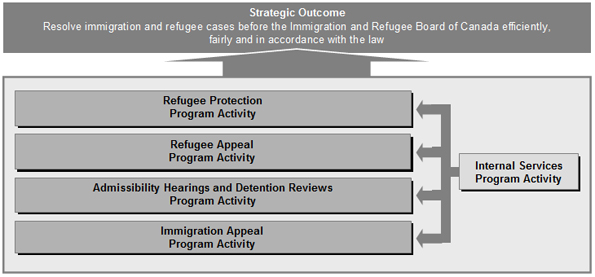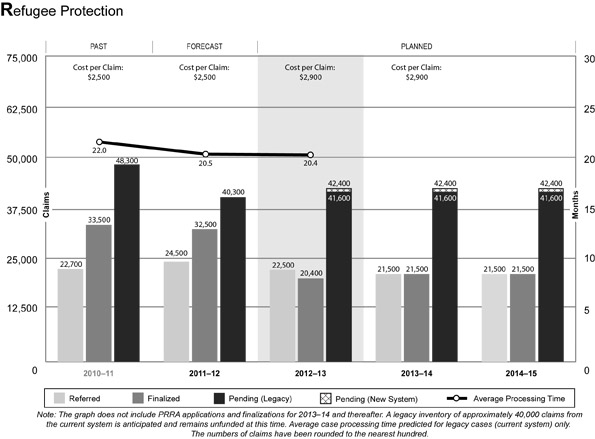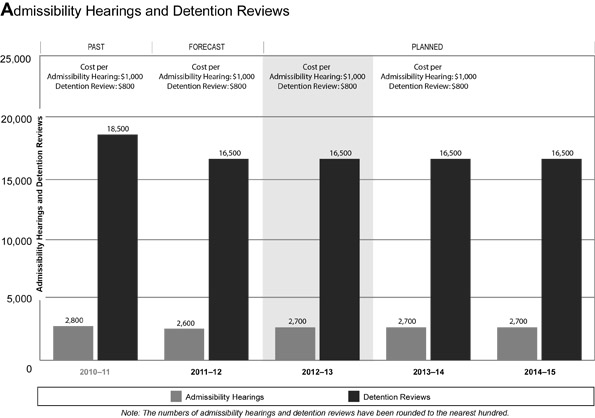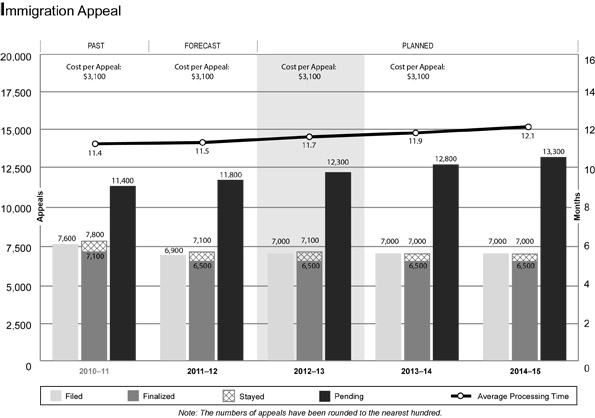Common menu bar links
Breadcrumb Trail
ARCHIVED - Immigration and Refugee Board of Canada - Report
 This page has been archived.
This page has been archived.
Archived Content
Information identified as archived on the Web is for reference, research or recordkeeping purposes. It has not been altered or updated after the date of archiving. Web pages that are archived on the Web are not subject to the Government of Canada Web Standards. As per the Communications Policy of the Government of Canada, you can request alternate formats on the "Contact Us" page.
Section II - Analysis of Program Activities
Strategic Outcome

As discussed in Section I, based on the IRB's legislated mandate and approved PAA, the IRB has a single strategic outcome. Each of its four core program activities are focused on the efficient and fair resolution of the different types of immigration and refugee cases. These activities, which are supported by Internal Services, are responsible for all tribunal decisions and case resolutions, and for a successful strategic outcome.
To achieve its strategic outcome, the IRB must resolve the cases before it in a timely manner while ensuring quality and fairness.
The following pages further describe the IRB's program activities, identifying expected results, performance indicators and targets, as well as outlining the resources dedicated to each of the five activities.
Program Activity 1: Refugee Protection
Description
The Refugee Protection Division (RPD) delivers the IRB's Refugee Protection program activity. It determines claims for refugee protection made in Canada. Processing of refugee protection claims is the largest of the IRB's activities and commands the majority of its resources. Through the work of the RPD, Canada fulfills its obligations as a signatory to a number of
international human rights conventions.
Additional information on the RPD is available at
www.irb-cisr.gc.ca/eng/tribunal/rpdspr/pages/index.aspx
Financial Resources ($ Millions)
| 2012–13 | 2013–14 | 2014–15 |
|---|---|---|
| 71.4 | 51.0 | 49.5 |
Human Resources (FTEs)
| 2012–13 | 2013–14 | 2014–15 |
|---|---|---|
| 556 | 437 | 445 |
| Performance Indicators | Targets |
|---|---|
| Clarity, completeness, conciseness and timeliness of decisions | Target is "Meet Expectations" on a scale of 1 to 3 where 2 represents "Meet Expectations." Measurements of decision quality for this program activity will be validated in the third quarter. Reporting will begin in 2013–14. |
| Percentage of designated country of origin (DCO) cases finalized within 150 days | 90% |
| Percentage of non-DCO cases finalized within 180 days | 90% |
| Average cost per case finalized | $2,900 |
| Number of finalized cases | 21,500 |
NOTES: At the time this report was finalized, this program activity was based on the coming into force of the BRRA on June 29, 2012. During the first quarter of 2012–13, this program activity will continue to operate under the current system and will then transition to the new system. Performance indicators presented above refer to the new system as set out in the BRRA. Targets are for a complete year of operation and are projected to be met by the end of 2013–14.
However, on February 16, 2012, the Government introduced the PCISA which, at coming into force, may further amend the BRRA and the IRPA. Following Royal Assent of the PCISA, the IRB will adjust the performance indicators and targets identified above as appropriate.
2012–13 Planning Highlights
New refugee determination system. As a result of the BRRA, the determination of refugee protection claims will go through a major transition during 2012–13. Cases will continue to be heard under the current system until June 29, 2012, when the new refugee determination system will come into force. The PCISA may amend the BRRA and its implementation timelines once it receives Royal Assent. The new legislation will bring significant changes to the way in-Canada protection claims are processed. Among other changes, short timelines will be imposed for the scheduling of hearings and RPD decision makers will be public service employees rather than GIC appointees.
The new RPD. The introduction of processing timelines for refugee protection claims will require changes to the way RPD decision makers and support staff carry out their work. The new RPD will be an oral reasons tribunal, in that all decisions and associated reasons will be rendered from the bench—at the conclusion of the hearing—unless it is not practicable to do so. The quality of RPD decisions will continue to be underpinned by up to date country of origin information, high quality legal advice and jurisprudential updates, ongoing member performance monitoring, and targeted training interventions when required.
Preparation for reform implementation. During the first quarter of fiscal year 2012–13, claims will be adjudicated under the current system while Board-wide reform planning and implementation efforts continue. Transition efforts will include a significant investment in training across the organization for everyone who will work on RPD cases in the new system, including registry staff, decision makers and their managers.
Case inventory. There will be approximately 40,300 refugee protection claims waiting to be heard at the beginning of 2012–13, which is well above the Division's capacity to address with existing resource levels. Further, overall finalizations in the RPD are expected to decrease in 2012–13 due to the transition to the new system, changes in personnel and some uncertainty with regard to decision maker mandates, appointments and reappointments. While the IRB will continue to strive to reduce the number of pending claims, following the coming into force of the new system IRB resources will be focused on rendering quality and fair decisions within legislated timelines. The finalisation of legacy cases after the coming into force of the BRRA remained unfunded at the time this report was prepared.
Pre-removal risk assessment. The transfer of the PRRA function from CIC to the IRB (except those cases requiring a balancing of Canada's security and protection interests) will take place no later than one year following the coming into force of the BRRA. Although decision making on PRRA applications will not begin until 2013–14, planning for the transfer already started in 2011–12 and will continue throughout 2012–13. At the time the current report was produced, the Government was also reviewing the timeline for the transfer of the PRRA function; it is expected to change once the PCISA receives Royal Assent.
Program Activity 2: Refugee Appeal
Description
The Refugee Appeal Division (RAD) will deliver the IRB's Refugee Appeal program activity. It will hear appeals from decisions of the Refugee Protection Division (RPD). The claimant or the Minister can appeal on a question of law, of fact or of mixed law and fact. The RAD will normally proceed without an oral hearing on the basis of the RPD record. The RAD may accept
documentary evidence and written submissions from the Minister and the person who is the subject of the appeal, as well as written submissions from a representative of the UNHCR and any other person provided for in the RAD Rules. Under narrowly defined circumstances, the RAD may hold an oral hearing.
Note: This program activity is currently scheduled to begin on June 29, 2012. The program activity or its implementation timelines could be amended as a result of the PCISA.
Financial Resources ($ Millions)
| 2012–13 | 2013–14 | 2014–15 |
|---|---|---|
| 18.0 | 22.1 | 22.1 |
Human Resources (FTEs)
| 2012–13 | 2013–14 | 2014–15 |
|---|---|---|
| 143 | 179 | 179 |
| Performance Indicators | Targets |
|---|---|
| Clarity, completeness, conciseness and timeliness of decisions | Target is "Meet Expectations" on a scale of 1 to 3 where 2 represents "Meet Expectations." Measurements of decision quality for this program activity will be validated in the last quarter. Reporting will begin in 2013–14. |
| Percentage of (no-hearing) designated country of origin (DCO) cases finalized within 30 days | 90% |
| Percentage of (no-hearing) non-DCO cases finalized within 120 days | 90% |
| Average cost per case finalized | $3,100 |
| Number of finalized appeals | 9,800 |
NOTES: At the time this report was finalized, this program activity was to be implemented with the coming into force of the BRRA on June 29, 2012. See below for more details. Targets are for a complete year of operation and are projected to be met by the end of 2013–14.
On February 16, 2012, the Government introduced the PCISA to further amend the BRRA and the IRPA. Following Royal Assent, the IRB will adjust the performance indicators and targets identified above as appropriate.
2012–13 Planning Highlights
Reform timelines. Cases will only begin to be processed in the Refugee Appeal program activity after refugee protection claims are decided in the new system, which is currently scheduled to come into force on June 29, 2012. This program activity and its implementation timelines may be amended by the PCISA once it receives Royal Assent.
Preparation for implementation. During the first quarter of 2012–13, the majority of activities will be focused on the development and implementation of the new RAD. These include the following:
- Newly established positions will be staffed. This will include the staffing of decision makers appointed by the GIC and public service employees in adjudicative support roles. The Chairperson may assign to the RAD decision-makers appointed by the GIC who are on strength when the new legislation comes into force. In the event that the number of GIC appointees on strength is insufficient to fill the anticipated number of positions in the RAD, the IRB will ask the Minister of Citizenship, Immigration and Multiculturalism to consider additional qualified candidates for recommendation to the GIC for appointment. In addition, the IRB will develop selection criteria, recruit and select personnel in accordance with the PSEA for public service positions providing support to the RAD.
- Following consultations with stakeholders, rules for the conduct of refugee appeals will be finalized.
- Policies, procedures and processes for the conduct of refugee appeals will be developed and implemented following consultations with stakeholders.
- A training program will be developed and delivered to decision makers and support personnel.
- Program requirements will be established and addressed.
Program Activity 3: Admissibility Hearings and Detention Reviews
Description
The Immigration Division (ID) delivers the Admissibility Hearings and Detention Reviews program activity. It holds hearings for foreign nationals or permanent residents who, under the provisions of the IRPA, are alleged to be inadmissible to Canada or are detained. Detainees must be seen by the ID within 48 hours after their detention or without delay thereafter, and
subsequent reviews must be conducted within specific statutory time frames. Decision-makers must balance the right to individual liberty with the security interests of Canadians.
Additional information on the ID is available at
www.irb-cisr.gc.ca/eng/tribunal/idsi/pages/index.aspx
Financial Resources ($ Millions)
| 2012–13 | 2013–14 | 2014–15 |
|---|---|---|
| 8.6 | 8.6 | 8.6 |
Human Resources (FTEs)
| 2012–13 | 2013–14 | 2014–15 |
|---|---|---|
| 65 | 65 | 65 |
| Performance Indicators | Targets |
|---|---|
| Clarity, completeness, conciseness and timeliness of decisions | Target is "Meet Expectations" on a scale of 1 to 3 where 2 represents "Meet Expectations." Measurements of decision quality for this program activity began in 2011–12. Reporting will begin in 2012–13. |
| Percentage of detention review cases concluded within statutory time frame | 96%1 |
| Percentage of admissibility hearings concluded within six months of referral | 86%2 |
| Average cost per detention review case | $800 |
| Average cost per admissibility hearing case | $1,000 |
| Number of finalized detention review cases | 16,500 |
| Number of finalized admissibility hearing cases | 2,700 |
1 Factors outside the IRB's control, such as prison lockdowns, impede the achievement of 100 percent compliance.
2 Detention reviews take priority over admissibility hearings due to legislative time requirements. The average processing time is also affected by the number of referrals from the CBSA.
2012–13 Planning Highlights
Sustained and more complex workload. The number of cases concluded by the ID depends largely on the number of cases referred by the CBSA. In its daily activities, the Division must deal with significant fluctuations in the number of detention reviews it is called upon to conduct. Through ongoing efforts to maintain efficiencies, the ID continues to match its output with its intake and to respect the legislated time frames for detention reviews.
During 2012–13, it is anticipated that the ID will experience a moderate increase in referrals for admissibility hearings. The number of detention reviews is expected to remain high, although it will likely be lower than in 2010–11, when the Division was faced with a large influx of marine arrivals which contributed to the high number of detention reviews conducted. The ID will continue to prioritize detention reviews to ensure that legislative requirements and fundamental rights are respected.
The Division will likely have to process more highly complex cases. These cases involve numerous legal applications, including applications for non-disclosure of information, as they normally refer to classified information related to national security or criminal intelligence. These cases require a disproportionate level of coordination and effort from decision-makers and from registry, security and legal staff as inadvertent disclosure of classified information could jeopardize national security and the lives of individuals.
Effective case management. In order to manage its caseload, the ID will continue to monitor scheduling activities to ensure that cases are processed in a timely fashion and that postponed cases are rapidly rescheduled. In order to conduct detention reviews within the legislated time frames, the Division needs to effectively use technologies such as videoconferencing, react rapidly to changing operational requirements and establish flexible operational processes. The Division also has to maintain effective coordination with registry services to ensure that cases are processed in a timely fashion in accordance with the law and the requirements of procedural fairness.
The ongoing use of case-readiness measures such as readiness conferences and follow-up will allow the Division to continue to finalize the vast majority of new admissibility cases within six months and maintain a reduced and manageable inventory of pending cases. The Division will continue to promote consistency in decision-making by identifying emerging issues, promoting open discussion among ID decision-makers on varying interpretations of the law, developing adjudicative tools and sustaining a learning environment for its decision makers.
To carry out its mission, the ID counts on a highly trained and dedicated workforce. The Division will continue to promote activities that support a healthy work-life balance and allow employees to realize their aspirations.
Program Activity 4: Immigration Appeal
Description
The Immigration Appeal Division (IAD) delivers the Immigration Appeal program activity. It hears immigration appeals from Canadian citizens and permanent residents whose applications to sponsor close family members to Canada have been refused. Other key functions include hearing appeals from permanent residents, foreign nationals with a permanent resident visa, protected
persons who have been ordered removed from Canada, and permanent residents outside Canada who are alleged to have not fulfilled their residency obligation.
Additional information on the IAD is available at
www.irb-cisr.gc.ca/eng/tribunal/iadsai/pages/index.aspx
Financial Resources ($ Millions)
| 2012–13 | 2013–14 | 2014–15 |
|---|---|---|
| 17.9 | 17.9 | 17.9 |
Human Resources (FTEs)
| 2012–13 | 2013–14 | 2014–15 |
|---|---|---|
| 118 | 118 | 118 |
| Performance Indicators | Targets |
|---|---|
| Clarity, completeness, conciseness and timeliness of decisions | Target is "Meet Expectations" on a scale of 1 to 3 where 2 represents "Meet Expectations." Measurements of decision quality for this program activity began in 2011–12. Reporting will begin in 2012–13. |
| Average case processing time | 11.7 months |
| Average cost per case | $3,100 |
| Number of appeals finalized | 6,500 |
2012–13 Planning Highlights
Decision-makers. The IAD's highly trained decision-makers conduct hearings that are varied in appeal type and process. The IAD is committed to effective management in which clear expectations and performance measures related to the quality and quantity of decisions are communicated to decision-makers and monitored.
Preparation for reform implementation. The IAD is sharing its experience and technical knowledge in relation to operating an appellate division through the participation of key personnel in RAD planning and implementation activities.
Inventory. The IAD is forecasting an intake of 7,000 appeals in 2012–13. The inventory of appeals awaiting finalization will increase to 12,300 by the end of 2012–13. Stayed removal order appeals, projected to be 1,900, are included in that pending inventory. A slight increase in the average processing time (from 11.5 to 11.7 months) is anticipated due, in part, to a reduction in the Alternative Dispute Resolution (ADR) program, linked to pressures on CBSA resources, resulting in fewer early finalizations without a hearing.
Case management. The IAD will continue to respond in a flexible manner to match resources with regional caseloads by sharing decision-makers among regions and by conducting hearings via videoconference where appropriate. Case management strategies will focus on increasing early resolution of appeals without a hearing (pending Minister's counsel availability for appeal hearings), enhancing hearing readiness, scheduling appeals strategically to increase efficiencies, and monitoring reasons for postponements and adjournments. The IAD remains committed to maintaining a high level of productivity and to rendering quality decisions in a timely manner.
Portfolio linkages. The IAD will continue to work with the CBSA to quickly finalize appeals that the CBSA has screened for early resolution and will promote the CBSA's continued participation in the ADR program. The IAD will also continue to facilitate the hearing of appeals where the Minister's counsel has chosen to participate through written submissions only. Work undertaken with the CBSA on case management innovations will continue, as always, to respect the adjudicative independence of IAD decision-makers.
Program Activity 5: Internal Services
Description
Internal Services are groups of related activities and resources required to support the needs of all four tribunal programs and other corporate obligations of the IRB. These services are: Management and Oversight; Communications; Legal; Human Resources Management; Financial Management; Information Management; Information Technology; Procurement and Assets Management;
Internal Audit and Evaluation; and other administrative services. Internal Services include only those activities and resources that apply across the organization and not those provided to a specific program.
Financial Resources ($ Millions)
| 2012–13 | 2013–14 | 2014–15 |
|---|---|---|
| 29.8 | 30.0 | 30.0 |
Human Resources (FTEs)
| 2012–13 | 2013–14 | 2014–15 |
|---|---|---|
| 265 | 265 | 265 |
2012–13 Planning Highlights
Communications. The IRB is committed to providing accurate and timely information to its partners, stakeholders and the public through its communications program and international activities. During 2012–13, the Board's activities will focus on supporting the implementation of the BRRA and the PCISA, once the latter receives Royal Assent. The IRB will continue to engage its key audiences to further their understanding of the Board's mandate and priorities, as well as of the operational changes expected to result from the new legislation.
Legal. Legal Services will focus its activities on the development of new rules and legal reference and training materials for the RPD, the RAD and the PRRA processes, as well as on the ongoing provision of advice, support and guidance related to the implementation of the new legislation. In addition, it will provide training and support to newly appointed decision-makers and offer advice, including risk analyses, regarding innovative adjudicative strategies. Legal Services will also continue to provide advice on all corporate matters including an expected increase in issues related to procurement and HR as a result of the implementation of the new refugee determination system. As well, it will continue to provide legal advice and support in relation to complex cases involving classified information related to national security or criminal intelligence.
Human resources management. The legislative and fiscal context will have significant bearing on HR management activities in 2012–13, with the focus continuing to be on preparation for the implementation of the new refugee determination system. Effective integrated human resources and business planning is crucial as the IRB manages its workforce during the transition period. Moreover, the IRB will continue to sustain the high quality of its HR practices and processes and to build further capacity with an emphasis on staffing. As part of its ongoing commitment to valuing people, IRB management will strive to maintain a healthy workplace and workforce.
Information management. During 2012–13, the IRB will continue to focus on alignment of its business with the Government's new service model for the outsourcing of document storage and retrieval services. The Board will develop business requirements and research available options for an IT solution to assist with the implementation of information management requirements.
Information technology. During 2012–13, the IRB will focus a significant portion of its IT resources on the modernization of existing legacy applications. This will support the successful implementation of the new legislation by enhancing the tracking and communication of key information related to the scheduling and managing of cases. The Board will also address new and emerging business priorities as well as system and infrastructure maintenance and upgrades. In addition, as previously outlined in this report, the IRB will continue to collaborate with the SSC to ensure the delivery of high quality IT services in such areas as email, data centers and network services.



